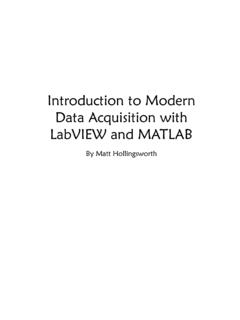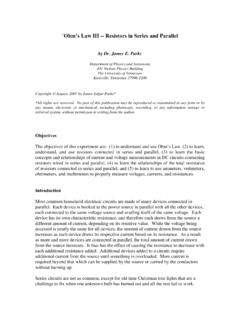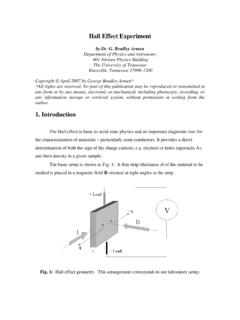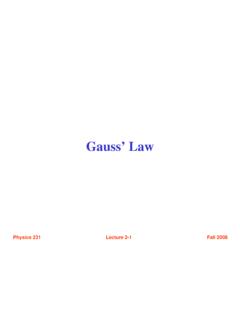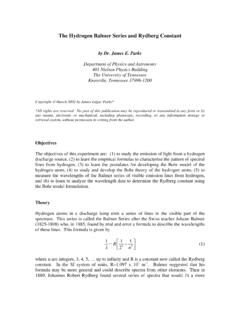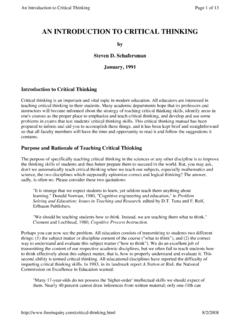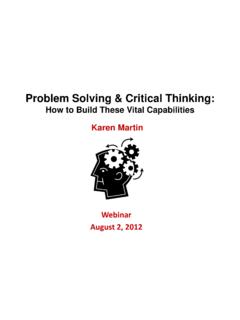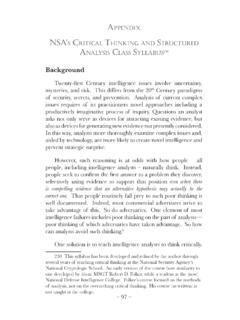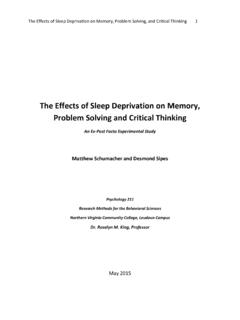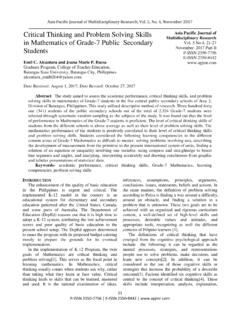Transcription of Problem Solving, Critical Thinking and else
1 Problem solving , Critical Thinking and else .. Norman Mannella The study of scientific disciplines offers to students extremely powerful tools for developing the skills of Critical Thinking that they will need to live in modern societies. Rapid scientific and technological progress, and unprecedented societal transformation require the ability to face new situations, analyze them, and quickly adapt to the changes. Citizens of the 21st century must become adept Problem solvers. Problem - solving ability is the cognitive passport to the future. Critical Thinking and Problem - solving skills are some of the most important assets that the study of physics can offer to students at any level, no matter what their future career paths will be. Fostering Critical Thinking skills is becoming one of the chief goals of education, particularly at the college level, where a variety of pedagogic techniques are being used to develop Critical Thinking skills in students.
2 (Irenton, Manduca and Mogk, 1996). Four fundamental features of natural human learning (Schank et al., 1995): Learning is goal-directed, failure-driven, case-based, it best occurs by doing. Education research has demonstrated what great educators have always known: Students acquire and retain knowledge most effectively when they must understand new information well enough to apply it to new situations, or to reformulate it into new ideas and knowledge. What so often counts most in schools is the important but incomplete cognitive resource of knowledge. Is it possible to teach Problem - solving abilities? Understand what Problem solving and Critical Thinking are Recognize the importance of heuristics Goal Management and Metacognition Intuitive learning: Provide an intuitive basis to concepts The role of imagination and examples Assumptions and Inferences Errors and uncertainty Yes, but.
3 What is Problem solving ? It is the process of moving toward a goal when the path to that goal is uncertain. We solve problems every time we achieve something without having known beforehand how to do so. What is Critical Thinking ? The intellectually disciplined process of actively and skillfully conceptualizing, applying, analyzing, synthesizing, and/or evaluating information gathered from, or generated by, observation, experience, reflection, reasoning, or communication, as a guide to belief and action. In its exemplary form, it is based on universal intellectual values that transcend subject matter divisions: clarity, accuracy, precision, consistency, relevance, sound evidence, good reasons, depth, breadth, and fairness. as Defined by the National Council for Excellence in Critical Thinking , 1987 A statement by Michael Scriven & Richard Paul, presented at the 8th Annual International Conference on Critical Thinking and Education Reform, Summer 1987.
4 What is Critical Thinking ? What is Problem solving ? The Nature of Problem solving Problem solving is the process of moving toward a goal when the path to that goal is uncertain. We solve a Problem when we do NOT know beforehand how to do it. There are NO SCRIPTS, NO FORMULAS for true Problem solving . If we know exactly how to get from point A to point B, then reaching point B does not involve Problem solving . Once we have mastered a skill, we are no longer engaged in Problem solving it. For a task to require Problem solving again, novel elements or new circumstances must be introduced or the level of challenge must be raised. Problems defy one-shot solutions: need to be broken down, with constant sub-goals monitoring Problem solving No script, no formulas vs. Algorithms straightforward procedures guaranteed to work every time Critical Thinking a set of information and belief generating and processing skills the habit, based on intellectual commitment, of using those skills to guide behavior The Nature of Critical Thinking retention of information alone the mere possession of a set of skills, because it involves the continual use of them the mere use of those skills ("as an exercise") without acceptance of their results vs.
5 Is it possible to teach Problem - solving abilities? Understand what Problem solving and Critical Thinking are Recognize the importance of heuristics Goal Management and Metacognition Intuitive learning: Provide an intuitive basis to concepts The role of imagination and examples Assumptions and Inferences Errors and uncertainty Yes, but .. Problem solving Like a maze: choose the path that seems to result in some progress toward the goal A heuristic is a rule of thumb, like a strategy which is powerful and general. Heuristics: cognitive "rules of thumb" An example of Heuristic Heuristics are usually picked up incidentally rather than identified and taught explicitly in school. This situation is NOT ideal. Problem solving Heuristics: cognitive "rules of thumb" A curriculum that encourages Problem solving needs to offer explicit instruction in the nature and use of heuristics.
6 In teaching Problem solving , major emphasis needs to be directed toward extracting, making explicit, and practicing Problem - solving heuristics Herbert Simon NOT absolutely guaranteed to work. Heuristics and knowledge are the "two blades" of effective profession al education, and "two bladed scissors are still the most effective kind. Herbert Simon Heuristics: examples means-ends analysis: form a sub-goal to reduce the discrepancy between your present state and your ultimate goal state. i. e.: do something to get a little closer to your goal Problems defy one-shot solutions; they must be broken down. Means-ends analysis accepts incremental advancement toward a goal. The method is not fail-safe Application of a series of tactical steps gets you closer toward the goal. Not simply a process of trial and error, steps taken are not blind or random. Rather, The benefits conferred by means-ends analysis may be as much emotional as intellectual.
7 Success in a small piece of a complex Problem can motivate one to persist. JUST DO IT!!! Heuristics: examples Working backward: First, consider your ultimate goal. From there, decide what would constitute a reasonable step just prior to reaching that goal. What would be the step just prior to that? Beginning with the end, you build a strategic bridge backward and eventually reach the initial conditions of the Problem . Working backward makes "next steps" plainer than simply wishing and hoping that dreams will materialize. Heuristics: examples Successive Approximations Start from a simpler Problem and build up the complexity Start with a seed and improve it External Representation Pictures, flow-charts The chosen representation of a Problem may help the solver see the Problem in a new way Facilitate communication with other individuals Facilitates goals management Is it possible to teach Problem - solving abilities? Understand what Problem solving and Critical Thinking are Recognize the importance of heuristics Goal Management and Metacognition Intuitive learning: Provide an intuitive basis to concepts The role of imagination and examples Assumptions and Inferences Errors and uncertainty Yes, but.
8 Then one cognitive challenge becomes goal management - keeping track of what to do and when. The process of generating sub-goals from goals, and then tracking the ensuing successful and unsuccessful pursuits of the sub-goals on the path to satisfying higher-level goals All heuristics help break down a Problem into pieces The decomposition of complexity consists of the recursive creation of solvable sub-problems, but the cost of creating embedded sub-problems, each with [its] own sub-goals, is that they require management of a hierarchy of goals Goal management is a major aspect of intelligent thought Goal Management Goal Management is an example of a more general phenomenon: one common feature of Problem solving is the capacity to examine and control one's own thoughts. This self-monitoring is known as metacognition. Metacognition is essential for Problem solving , need to be aware of the current activity and of the overall goal, the strategies used to attain that goal, and the effectiveness of those strategies.
9 The mind exercising metacognition asks itself, What am I doing? How am I doing? These self-directed questions are assumed in the application of all heuristics. However, in practice, teachers cannot simply assume that students will engage in metacognition; it must be taught explicitly as an integral component of Problem solving . Metacognition When solving problems, means shift continually depending on one's position relative to desired goals. Maintaining flexibility is essential. Too often we feel wedded to a chosen strategy and continue to apply that strategy even if it leads us nowhere .. "What do I do now, given my goal, my current position, and the resources avail able to me?" Getting off course along the way is fully expected. Cool-headed reappraisal is the best response not mind less consistency, panic, or surrender. Problem solving requires both the vigilant monitoring and the flexibility permitted by metacognition Metacognition Anxiety is a spoiler in the Problem - solving process.
10 It stalks right behind uncertainty, ready to pounce. Demanding and uncertain environments, the seedbeds of all Problem solving , are fertile ground for anxiety. Uncertainty is an integral part of the business of solving problems. Those who cannot bear situations in which it is impossible to see the way clearly to the end are emotionally ill-prepared to solve problems. Do not let anxiety take hold Is it possible to teach Problem - solving abilities? Understand what Problem solving and Critical Thinking are Recognize the importance of heuristics Goal Management and Metacognition Intuitive learning: Provide an intuitive basis to concepts The role of imagination and examples Assumptions and Inferences Errors and uncertainty Yes, but .. We can learn concepts at various levels of depth If we memorize an abstract definition of a word and do not learn how to apply it effectively in a wide variety of situations, NO intuitive foundation for our understanding.
